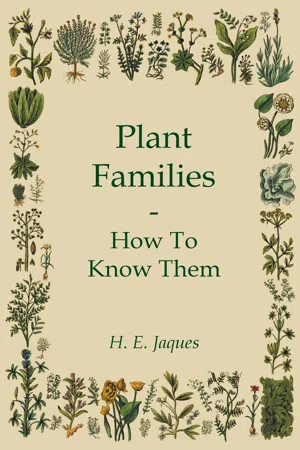
- 188 pages
- English
- ePUB (mobile friendly)
- Available on iOS & Android
eBook - ePub
Plant Families - How To Know Them
About this book
"Plant Families – How To Know Them" is a 1948 guide to identifying plants by H. E. Jaques. It aims to teach the reader how to readily attribute any and every plant they see to its proper family, as well as to provide them with a general understanding of the characteristics of said family of trees. This accessible and profusely-illustrated guide will appeal to nature lovers and is not to be missed by those with a keen interest in gardening. Contents include: "Some Plant Facts", "A List of Reference Books", "How to Use the Keys", "Pictured-Keys for Identification of the Families of Plants", "Algae", "Lichens", "Mosses and Liverworts", "Ferns", "Flowering Plants", "A List of the Families of Plants in Their Logical Order", and "Index and Illustrated Glossary". Many vintage books such as this are increasingly scarce and expensive. It is with this in mind that we are republishing this volume now in an affordable, modern, high-quality edition complete with a specially-commissioned new introduction on the history of gardening.
Frequently asked questions
Yes, you can cancel anytime from the Subscription tab in your account settings on the Perlego website. Your subscription will stay active until the end of your current billing period. Learn how to cancel your subscription.
At the moment all of our mobile-responsive ePub books are available to download via the app. Most of our PDFs are also available to download and we're working on making the final remaining ones downloadable now. Learn more here.
Perlego offers two plans: Essential and Complete
- Essential is ideal for learners and professionals who enjoy exploring a wide range of subjects. Access the Essential Library with 800,000+ trusted titles and best-sellers across business, personal growth, and the humanities. Includes unlimited reading time and Standard Read Aloud voice.
- Complete: Perfect for advanced learners and researchers needing full, unrestricted access. Unlock 1.4M+ books across hundreds of subjects, including academic and specialized titles. The Complete Plan also includes advanced features like Premium Read Aloud and Research Assistant.
We are an online textbook subscription service, where you can get access to an entire online library for less than the price of a single book per month. With over 1 million books across 1000+ topics, we’ve got you covered! Learn more here.
Look out for the read-aloud symbol on your next book to see if you can listen to it. The read-aloud tool reads text aloud for you, highlighting the text as it is being read. You can pause it, speed it up and slow it down. Learn more here.
Yes! You can use the Perlego app on both iOS or Android devices to read anytime, anywhere — even offline. Perfect for commutes or when you’re on the go.
Please note we cannot support devices running on iOS 13 and Android 7 or earlier. Learn more about using the app.
Please note we cannot support devices running on iOS 13 and Android 7 or earlier. Learn more about using the app.
Yes, you can access Plant Families - How To Know Them by H. E. Jaques in PDF and/or ePUB format, as well as other popular books in Biological Sciences & Botany. We have over one million books available in our catalogue for you to explore.
Information
PICTURED-KEYS FOR IDENTIFYING THE FAMILIES OF THE ENTIRE PLANT KINGDOM
There are more than 250,000 known species of plants. A life time of specialization would be needed to know most of them intimately. But these many species fall into a few hundred families. An earnest student or careful observer can acquaint himself with so many of these families that he will recognize the relationships of the majority of the plants he sees, no matter how widely he travels. The family makes the best unit for a thorough general knowledge of plants or animals.
To secure a clear picture of the plant kingdom is is necessary to begin with the larger groups. The reader will now gather up his equipment of keen eyes, alert mind, and good perseverance and he is ready to start on a most fascinating journey through the Kingdom of Plants.

KEY TO THE PRINCIPAL GROUPS OF PLANTS
The plants are usually divided into four great groups. It is commonly recognized that some of these groups are “artificial”. The Thallophyta in particular includes many plants which are somewhat alike in their simplicity but which are evidently widely disrelated.
1a Plants without distinction of root, stem and leaf; without flowers, both aquatic and terrestrial; algae; fungi, and lichens. “HAVE NO ARCHEGONIA”. Figs. 1 to 200.
Division THALLOPHYTA page 8
1b Plants with distinct leaves; with or without roots or flowers. | 2 |
2a Small plants (to 4 or 5 inches tall) with green or gray-green leaves, or tiny leaf-like forms on damp earth or floating on water. No true roots or flowers. (Some small oval green discs floating on quiet water with roots suspended beneath are flowering plants and do not belong here.) “HAVE ARCHEGONIA BUT NO VASCULAR BUNDLES”. (Mosses and Liverworts.) Figs. 201 to 253.
Phylum BRYOPHYTA page 69
2b Plants with true roots and vascular bundles; mostly with veiny leaves. | 3 |
3a Plants without flowers or seeds, herbs (not woody), propagated by spores. Figs. 254 to 265. “HAVE VASCULAR BUNDLES BUT NO SEEDS”. (The Ferns, etc.)
Phylum PTERIDOPHYTA page 86
3b Plants with flowers (sometimes very simple; one tiny stamen or one pistil may constitute a flower) and seeds. “HAVE SEEDS”.
Figs. 266 to 472. (The seed-bearing plants.)
Phylum SPERMATOPHYTA page 89
THE THALLOPHYTA
1a (a, b, c) Plants green, with chlorophyll, thus organizing their own food by photosynthesis. Figs. 1 to 116.
Sub-division PHYCOPHYTA, The Algae 2
1b Plants without chlorophyll (not green). Living parasitically on living plants or animals or as saprophytes on dead, organic matter. Figs. 127 to 200.
Sub-division MYCOPHYTA, The Fungi page 44
1c Dual organisms in which a green plant species (alga) is held in parasitic embrace by a species of fungus. Usually gray-green or yellow-green but sometimes displaying bright colors. Common on tree trunks, rocks and often growing directly on the ground.
Figs. 117 to 126.
The Lichens page 41
KEYS TO THE FAMILIES OF THE ALGAE
2a Plant cells without recognizable nucleus... |
Table of contents
- Cover
- Title
- Copyright
- A Short History of Gardening
- Introduction
- Contents
- Some Plant Facts
- A List of Reference Books
- How to Use the Keys
- Pictured-Keys for Identification of the Families of Plants
- A List of the Families of Plants in their Logical Order
- Index and Illustrated Glossary